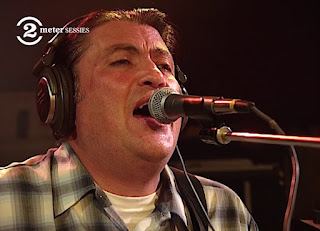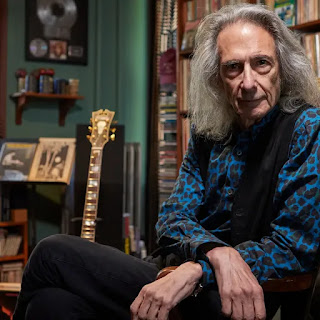This is almost a companion piece to ART58Koen's Elvis screed in its way, but here the truth is stranger than the fiction...
If forming a band is like getting married, then 10cc had a more interesting courtship, relationship, divorce and later life apart than most. Of course, marriages don't usually involve four people, but 10cc managed to embrace the concept of the "odd couple" during their time together.
 |
| Creme, Gouldman, Godley & Stewart |
For eight years before the band was formed in 1972, the future members - Lol Creme, Kevin Godley, Eric Stewart and Graham Gouldman - came together and flew apart repeatedly in a dizzying and increasing number of projects including bands, compositions and recordings. None of this came to much, but it did provide a sound basis for all the participants in the crafts of recording and writing, even though artistic satisfaction was hard to find and, for some, initial commercial success even harder. Above all, it established the relationships which eventually combined to form 10cc.
To cut a very long and involved story short, 1969 found all four members of the future 10cc working together regularly at Strawberry Studios in Stockport. Gouldman - already a very successful songwriter indeed - was contacted by American bubblegum pop writer-producers Jerry Kasenetz and Jeffry Katz and commissioned to write and produce bubblegum songs. Gouldman agreed, and eventually all this material would be produced at Strawberry Studios over an intensive three month period using Godley, Creme and Stewart as musicians.
 |
| Mr & Mr Bubblegum |
Gouldman carried on working for Kasenetz-Katz, but came together occasionally with the other three future 10cc members who were continuing to record, produce, engineer and write, and thus gain valuable experience working with other artists, of which more later on in this screed.
However, it was the first album the four of them produced with Neil Sedaka which galvanised them into forming a permanent band.
As Gouldman put it: It was Neil Sedaka's success that did it, I think. We'd just been
accepting any job we were offered and were getting really frustrated. We
knew that we were worth more than that, but it needed something to prod
us into facing that. We were a bit choked to think that we'd done the
whole of Neil's first album with him just for flat session fees when we
could have been recording our own material.
In fairly short order 10cc was formed and the rest, as they say, is history. Four years of chart success followed for the quartet, and their complex and arty songs performed in a broadly pop style hold up really well, even today.
 |
| In Strawberry Studios |
The original foursome fell into two camps - Gouldman and Stewart were very pop orientated, whilst Godley and Creme were more "experimental". Initially, the four managed to reconcile and merge their different musical inclinations, but eventually it became obvious that the inherent dichotomy was irreconcilable, and Godley and Creme quit.
To cut yet another long story short, Godley and Creme went on to score hits of their own and become heavily involved in pop video production. Gouldman and Stewart recruited new members, and had even more success with 10cc until Stewart left to work with some bloke called Paul McCartney, and then go on to record a handful of solo albums. Gouldman still tours 10cc, makes solo recordings and recently joined Ringo Starr's All-Starr Band,
The whole 10cc story deserves far more detail than my treatment of it, but it's complex and goes off at so many tangents. It's certainly a tortured tale that this blog will revisit in the future, but for now I've chosen one very brief but extremely bizarre episode from their past.
Kimberley Barrington Frost was born in 1934 to musical parents. His father was a tenor and his mother played piano to accompany silent movies. He was called up to the Royal Air Force and eventually became a PT instructor. He completed his national service in 1960, and eventually settled to working as a plumber by day and jazz singer by night. In 1968 he claimed to have been visited, whilst driving to a plumbing job, by the spirit of the Pharaoh Ramesses, who told him that he was the pharaoh's earthly reincarnation. He remodeled his Sheffield home in Egyptian style, shaved his head and started dressing in long flowing silk robes, and also persuaded his wife to change her name from Dorothy to Selket, whilst he became Ramases (sic). The couple finally committed to this change of lifestyle by taking up a joint career in music, as commanded by the Pharaoh's spirit.
 |
| Walk like an Egyptian... |
So, Ramases (band or solo act - who knows?) was formed and this is where the future 10cc comes on the scene.
Needing an outlet for telling the World about the Universe - the ultimate mission according to the Pharaoh - Ramases signed with a couple of labels and released a couple of singles which proceeded to sink without trace.
However, Vertigo Records signed Ramases in 1971 and the new act recorded an album called "Space Hymns" at Strawberry Studios with Godley, Creme, Stewart and Gouldman as backing musicians, arrangers and producers.
Roger Dean was hired to produce what was his most lavish album art to date, with a six panel fold out cover showing Stockport's St George's Church steeple lifting off into space.
 |
| We have lift off! |
Why a church? Ramases explains: "The rocket ship shape of churches probably dates back to Moses' visit to speak to God on the mountain and what he saw there."
Right...
As for the music...well, it seems to straddle some sort of largely uncharted territory between trippy psychedelic folk and Hawkwind style space rock. I'm not going to attempt to describe it in any depth, although I'll just say that it sounds very much better than it deserves to, after taking all the reincarnated pharaoh mumbo-jumbo into account. A few tracks have a sort of pop/folk rock vibe which works well with Frost's songs. Indeed, a couple of them wouldn't sound too out of place on an early 10cc album.
Needless to say, "Space Hymns" stiffed - as did a second album cheerily entitled "Glass Top Coffin". This didn't feature anyone from 10cc, but used members of the Royal Philharmonic and London Symphony Orchestras instead.
Discouraged by his lack of success, Frost apparently took his own life in 1978, leaving an unreleased album which gained partial release on a six CD box set retrospective, despite reports of his widow's jealous second husband burning Frost's surviving tapes.
Phew!
To hear "Space Hymns" - you know you want to! - just answer the risibly simple question in the comments below.






.jpeg)































